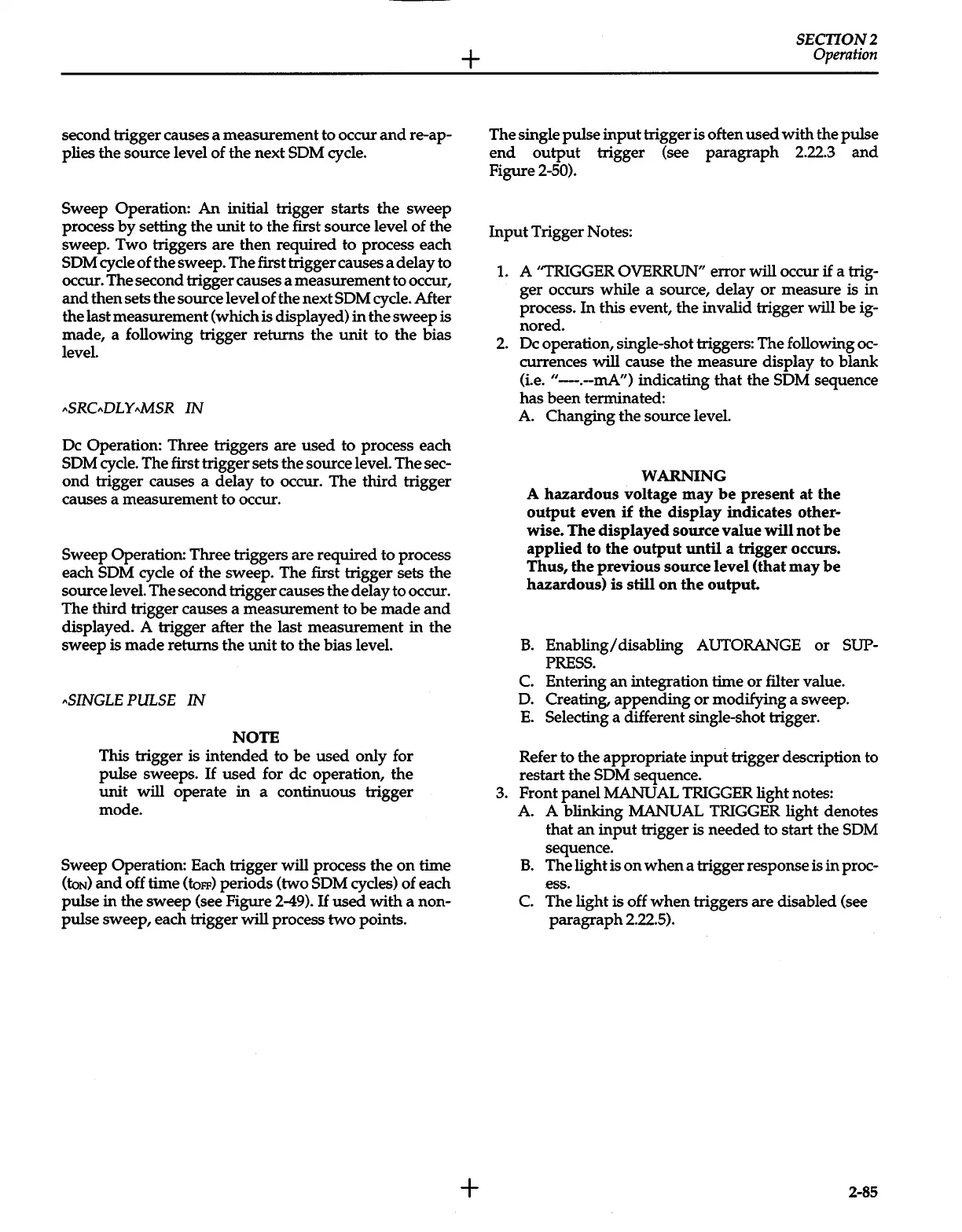second trigger causes a
measurement
to occur
and
re-ap-
plies
the
source level
of
the
next SDM cycle.
Sweep Operation:
An
initial trigger starts
the
sweep
process
by
setting
the
unit
to
the
first source level
of
the
sweep.
Two
triggers
are
then
required
to process each
SDM cycle
of
the
sweep. The first trigger causes a
delay
to
occur. The second trigger causes a
measurement
to occur,
and
then
sets
the
source level
of
the
next SDM cycle. After
the
last
measurement
(which is displayed)
in
the
sweep
is
made,
a following trigger
returns
the
unit
to
the
bias
level.
"SRC,.DLY,.MSR
IN
De Operation: Three triggers
are
used
to
process each
SDM cycle. The first trigger sets
the
source level.
The
sec-
ond
trigger causes a
delay
to
occur.
The
third
trigger
causes a
measurement
to
occur.
Sweep Operation: Three triggers
are
required
to
process
each SDM cycle
of
the
sweep. The first trigger sets
the
source level.
The
second
trigger causes
the
delay
to
occur.
The
third
trigger causes a
measurement
to
be
made
and
displayed. A trigger after
the
last
measurement
in
the
sweep
is
made
returns
the
unit
to
the
bias level.
"SINGLE PULSE
IN
NOTE
This trigger is
intended
to
be
used
only
for
pulse
sweeps.
If
used
for
de
operation,
the
unit
will operate
in
a continuous trigger
mode.
Sweep Operation: Each trigger will process
the
on
time
(toN)
and
off time
(toFF)
periods
(two SDM cycles) of each
pulse
in
the
sweep
(see Figure 2-49).
If
used
with
a
non-
pulse
sweep, each trigger
will
process
two
points.
+
+
SECTION2
Operation
The
single
pulse
input
trigger is often
used
with
the
pulse
end
output
trigger (see
paragraph
2.22.3
and
Figure 2-50).
Input
Trigger Notes:
1. A ''TRIGGER OVERRUN"
error
will
occur
if
a trig-
ger
occurs
while
a source, delay
or
measure
is
in
process.
In
this event,
the
invalid trigger
will
be
ig-
nored.
2. De operation, single-shot triggers: The following oc-
currences
will
cause
the
measure
display to
blank
(i.e.
"-.--mA")
indicating
that
the
SDM sequence
has
been
terminated:
A.
Changing
the
source level.
WARNING
A
hazardous
voltage
may
be
present
at
the
output
even
if
the
display
indicates
other-
wise.
The
displayed
source
value
will
not
be
applied
to
the
output
until
a
trigger
occurs.
Thus,
the
previous
source
level
(that
may
be
hazardous)
is
still
on
the
output.
B.
Enabling/
disabling AUTO RANGE
or
SUP-
PRESS.
C. Entering
an
integration time
or
filter value.
D. Creating,
appending
or
modifying a sweep.
E.
Selecting a different single-shot trigger.
Refer
to
the
appropriate
input
trigger description to
restart
the
SDM sequence.
3.
Front
panel
MANUAL
TRIGGER light notes:
A.
A blinking MANUAL TRIGGER light denotes
that
an
input
trigger is
needed
to
start
the
SDM
sequence.
B.
The
light
is
on
when
a trigger response is
in
proc-
.ess.
C.
The
light is off
when
triggers
are
disabled (see
paragraph
2.22.5).
2-85

